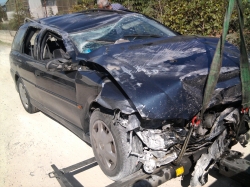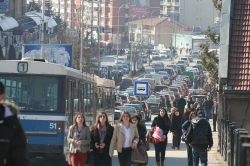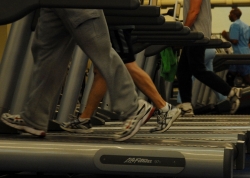Our bodies are made up of many different systems that work together, but sometimes parts do not work the way that they should. One of the most important systems in our body is the circulatory system, which is made up of the heart, blood, and blood vessels. Just like any machine, the parts of the circulatory system can break down. This is a serious problem -- if one part is broken, the rest of the system may not work at all. Since we cannot live without a working heart, any problems that happen in the heart or blood vessels are very dangerous. Your heart is your life! The following information describes some problems that we can have with our hearts.

Ouch, that hurt.
To start things off, we first must understand coronary circulation. Coronary circulation is the name for the flow of blood to and from the heart. "Coronary" is a word used to describe heart issues. Your heart is a muscle, and it needs blood just like the rest of your body!
Coronary circulation involves two kinds of blood vessels. The heart's arteries carry blood with oxygen into your heart while the veins carry the blood full of waste out of your heart. These blood vessels are incredibly important because all the blood for your whole body flows into and out of your heart. If these blood vessels are damaged, then the whole body may stop working! Because they are so important, many of the worst heart problems deal with the arteries and the veins.
Heart attacks are one of the most common heart problems. A heart attack occurs when the blood carrying oxygen is blocked from reaching the heart. The blood can't reach the heart because the arteries are blocked. Arteries can become blocked for a number of reasons, but the most common is the build up of bad stuff called "plaque" on the walls of the blood vessels. If too much plaque sticks to the sides of your blood vessels, then blood cannot flow to the heart. Without blood flow the heart will stop working. This is just like a car that runs out of gas; if there is no gas in the car then the car will not be able to move. If blood carrying oxygen does not reach your heart then your heart won't work -- a heart attack will happen.

Wow, it's really hard to get to school when the road is blocked.
Sometimes even the parts of your blood that are usually helpful can cause problems. Your blood has cells that prevent blood from leaving your body when you get a cut. A blood clot is when different parts of your blood stick together to stop blood from flowing. When you get a cut on your knee, clots form to help stop the bleeding. Sometimes a clot forms inside of your blood vessels when you do not have a cut. Having a blood clot inside of your blood vessels can mean that your blood might not be able to get to your muscles and other important parts of your body. In a way, a blood clot is like a big car crash that makes all the rest of the cars stop moving. The crash stops all of the other cars from going where they need to go, just as the blood clot stops all of the rest of the blood from going where it needs to go.
These blood clots inside blood vessels can cause a stroke. Someone has a stroke when blood stops flowing to a part of the brain. Sometimes strokes are even called "brain attacks" because just as a heart attack stops the heart from working because it is not getting the blood it needs, a stroke stops the brain from working because it is not getting the blood it needs.
A stroke can cause many different changes in a person's brain, depending on what part of the brain lost blood flow and how long it was without blood. Sometimes people who have had a stroke cannot talk or use part of their body; sometimes people show no signs of brain damage at all. The people who show no signs of a problem after a stroke are benefiting from the fact that the brain is an amazing thing; even if a part of it dies, other parts can take over the jobs that the dead part once did!

All these treadmills and not one is open? How am I supposed to get any exercise?
One easy way to think of the flow of blood through your blood vessels is to compare it to cars driving on roads. If a road is too narrow, then very few cars can drive on it at once; if a blood vessel has too much plaque stuck on its walls, then very little blood can flow through it. If a car crash blocks the entire road, then the rest of the cars cannot get to where they need to go. Likewise, if a blood clot happens in a blood vessel, then the rest of blood cannot get to the organs and muscles that it needs to reach. Fortunately, there are various ways to help prevent the "roads" of your body from getting blocked. For example, eating healthy food and exercising often can help keep these "roads" of your body healthy and clear, but at the same time, eating fats and smoking can block these same "roads."

Everybody likes fish.
However, not all fats are bad. There is actually a kind of fat called unsaturated fat that does not hurt your heart. Omega-3 fatty acid is one of these special healthy kinds of fat. It can be found in fish, so scientists say that it is good idea to eat fish at least once a week in order to help keep your heart healthy. At the same time, foods that have a lot of fiber in them have been shown to lower the chance of heart disease as well. Fruits, vegetables, and foods made with whole grains all have fiber in them.
Fiber is an interesting compound. Even though it is important for our heart's health, our bodies cannot actually digest fiber like they digest other foods. Instead, fiber acts like a broom in our bodies; it helps clean out all the bad stuff as it passes through our digestive system. This helps your heart because it can prevent the build up of bad stuff inside our digestive system that might end up in our arteries. Scientists are not sure how this works, but they think that fiber does this by attaching itself to the bad stuff and making it leave the body instead of staying inside. Also, people that eat a lot of fiber are less likely to eat bad foods because fiber makes you feel fuller for longer!